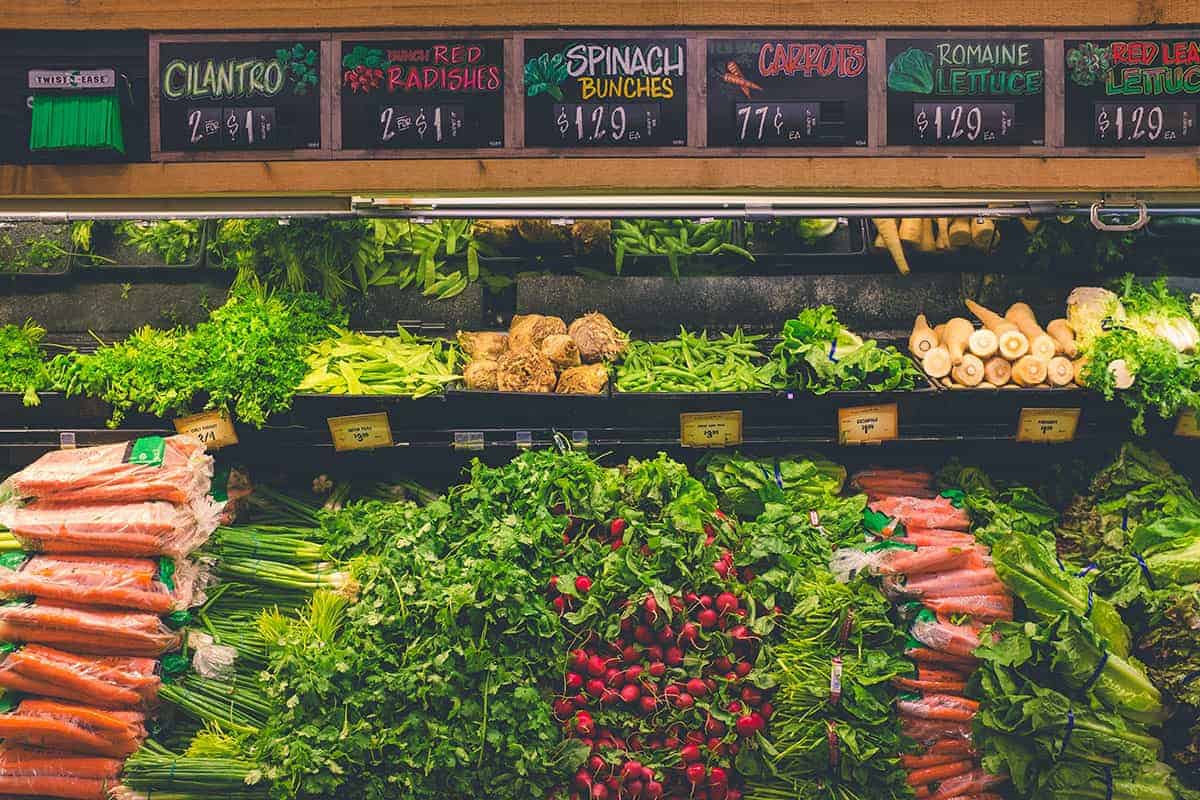Have you ever wondered if you’re spending the “right” amount of money on the food you buy for your family? Or feeling like you’re spending too much? Me too! I bet you have! We’re going to get into how to make a food budget, how to know if you’re being realistic, and easy ways to save money on food…and still eat really well.

Food Budgets
Creating and sticking to a food budget is one of those things that we feel like we should do as adults—and a really helpful way to stay on top of monthly expenses. It may not be the most fun thing in the world, but it’s one of the best ways to manage household expenses.
I know it can be daunting to know where to start, or how to reevaluate if you’re trying to tighten you budget, so I’ll do my best to walk through a straight forward process to help.
Table of Contents

Factors to Consider
For me, coming up with my food budget takes these factors into consideration:
- How many people are in the family?
- How old is everyone and how much do they typically eat?
- How many meals does everyone eat at home (versus at school, daycare, or work)?
- How many meals a week are typically eaten at a restaurant (or as takeout)?
- Do we have priorities in terms of organic and sustainable food?
- Where do we shop? Are there less expensive alternatives nearby?
- How much meat and fish do we prefer to eat each week?
- What’s my range of available income to use towards my food expenses?
- How comfortable am I adjusting other expenses to allow more (or less) for food?
TIP: I use the YNAB budgeting software, which is so helpful in tracking and allocating funds for every sort of expense in my budget.
Food Budget Calculator
If you want to try calculating what your food budget should be based on the actual price of food, you can try using this calculator from Iowa State. It’s based on data from the USDA and is a really fascinating place to start.
I also find it to be reassuring that most of us are actually probably not overspending in the way we think we are. Food actually is expensive!
USDA Food Budget
Did you know that the USDA releases a food plan each month that shows the average cost of feeding a family at home? These are the figures that feeding a family should cost if you’re doing all meals at home and eating based on the principles in MyPlate.
There are a few different levels of the plan including Thrifty, Low-Cost, Moderate, and Liberal, and it’s broken down further by the number of people in your house.
This too is a really helpful resource to get a sense of perspective when thinking about food budgeting.
This doesn’t adjust for where you live or where you shop, but it’s VERY eye opening when it comes to the actual cost of food. It actually helped me to relax a little bit about what I’ve been spending on food—especially in the context of food being a very important part of my family’s health and wellness.
(And since we like to use our food dollars to support sustainable farming and local farmers when we can, which can cost more.)
Definitely take a look at this if you feel like you’re spending too much just for some perspective on what might be normal.
Step-by-Step Instructions
Here’s a straight forward step-by-step plan to create and stick to a food budget:
- Look at the available money you have for food each month based on previous month’s income. (If you aren’t sure, just keep track for a month and then start this.)
- Look at past receipts from the store to see how far over or under you are comparing your budget to your actual spending habits.
- Consider these way to save on groceries if you need to cut spending. (Or if it might be easier to trim spending on things like eating out instead, since that is often much more straight forward.)
- Sign up for your store’s rewards programs or try a grocery saving app like Ibotta.
- Swap in more vegetarian meals (and less meat), and less prepared foods. Those two things are often the biggest expenses and straight forward ways to trim food costs.
- Take stock of your pantry, fridge, and freezer before you head to the store to make sure you use what you already have.
- Try a meal planning system to help you not overbuy each week.
- Consider relying more on school meals if you have school aged kids.
- Look into WIC if you qualify.
- Try shopping at less expensive stores for some staples each month. (I usually stock up on pantry staples at Walmart once a month and it really helps.)
- Reassess regularly to see if your budget is realistic for your family.
TIP: Remember that the cost of food will vary, and will sometimes vary a LOT, depending on where you live and the options for buying that you have access to.
How to Reduce Food Waste
Not using the food we buy is one of the biggest ways that we waste money. If that feels true to you, try:
- Take stock of the pantry, fridge and freezer before going to the store and see what you can put into the meal plan.
- Serve little kids very small portions to start to reduce how much they may potentially waste.
- If you have produce that needs to last, try these tips to make it last longer.
- Try freezing milk if you can’t use it before it goes bad.
- Rely on simple ideas like Snack Dinners to clear out the pantry before shopping for more.
- Put leftover fruit and veggies (like zucchini, summer squash, avocado, shredded carrot, sweet potato, and butternut squash) into a freezer bag and use for future smoothies.
- Put leftover bananas into a freezer bag, then thaw and mash to use in baked goods like Banana Bread.
TIP: Find my full list of tips for reducing food waste.
You May Also Like
I’d love to hear your feedback on these tips, so please comment below to share!
This post was first published September 2019.



















This is great advice, especially when food insecurity is such a big issue at the moment and most of us have never been taught how to budget.
There was a report that came out here in the UK last month called The Broken Plate 2021, which stated that eating healthily costs around 3 times as much per 1000caleries as it does to buy convenience foods and that those who are in the lowest socioeconomic groups spend around 40% of their disposable income on food, where those in the highest bracket spend around 7%.
So much work needs to be done on making the healthy options the affordable ones!!
All so true!